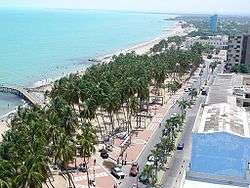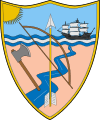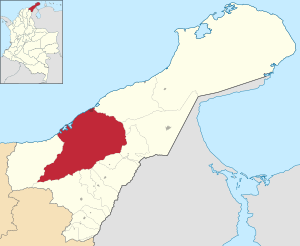Riohacha
Riohacha (Spanish pronunciation: [rjoˈa.tʃa]), Rio Hacha or Rio de la Hacha (English: River of the Axe or Axeshore - Wayuu: Süchiimma, "Süchii" means river, and "mma" means land, Riverland), is a city in the Riohacha Municipality in the northern Caribbean Region of Colombia by the mouth of the Ranchería River and the Caribbean Sea. It is the capital city of the La Guajira Department. It has a sandy beach waterfront.
Riohacha | |
|---|---|
City and municipality | |
 View of Riohacha beachfront | |
 Flag  Seal | |
 Location of Riohacha in the Department of La Guajira. Municipality (red), city (black dot). | |
 Riohacha Location of Riohacha in the Department of La Guajira. Municipality (red), city (black dot). | |
| Coordinates: 11°32′39″N 72°54′25″W | |
| Country | |
| Region | Caribbean |
| Department | La Guajira |
| Foundation | 1535 |
| Founded by | Nikolaus Federmann |
| Government | |
| • Mayor | Rafael Ceballos Sierra (L)[1] |
| Area | |
| • City and municipality | 3,120 km2 (1,200 sq mi) |
| Elevation | 5 m (16 ft) |
| Population (2018 Census)[2] | |
| • City and municipality | 188,014 |
| • Density | 60/km2 (160/sq mi) |
| • Urban | 126,103 |
| Time zone | UTC-05 (Eastern Time Zone) |
| Postal code | 440001 |
| Area code(s) | 57 + 5 |
| Climate | BSh |
| Website | Official website (in Spanish) |
| *Riohacha metropolitan area is yet to be determined. | |
Founded by conquistador Nikolaus Federmann in 1535, Riohacha was named after a local legend, "The legend of the Axe". Because of the powerful rain shadow of the Sierra Nevada de Santa Marta, the area is mostly desertic. It is inhabited primarily by Amerindians, predominantly the Wayuu ethnic group. During colonial times, Riohacha was a very important port, as divers could retrieve vast numbers of pearls from the harbor.
In the second half of the 20th century, the city developed as one of Colombia's medium important, maritime commercial ports. It is also a multicultural center for La Guajira Department. The city is mentioned several times in novels written by Colombian writer Gabriel García Márquez, who won the Nobel Prize in Literature. Among his important works are One Hundred Years of Solitude, Love in the Time of Cholera, and Chronicle of a Death Foretold.
History

The Riohacha area was long inhabited by American Indians of the Wayuu culture, part of the larger Arawak group. The first European to visit the area was the Spanish sailor Alonso de Ojeda in 1498, though he never landed. A short time later, Juan de la Cosa, another Spanish explorer, landed on what is today called Cabo de la Vela (Cape of the Sail, so called because of its shape). In 1535, the German explorer Nikolaus Federmann founded a city with the name Nuestra Señora Santa Maria de los Remedios del Cabo de la Vela (Our Lady Saint Mary of the Remedies of the Cape of the Sail) at the place where de la Cosa had landed.
The Spanish discovered a vast amount of pearls in the city's area This treasure frequently attracted raids by pirates. After the city was destroyed by a pirate raid, the city government relocated the city to the mouth of the Ranchería River, in order to confuse the pirates, and to give the city time to rebuild before the next attack. The new city, named Nuestra Señora de los Remedios del Río de la Hacha (Our Lady of the Remedies), expanded peacefully for a short time in its new location. Pirate attacks soon resumed. The next major attack, led by the famous English pirate Francis Drake, took place in 1569, when Drake pillaged the city searching for gold and pearls.
In the 18th century, Riohacha was incorporated to the Viceroyalty of New Granada as part of the province of Santa Marta. During the battles for independence from Spain, the port of Riohacha served many vessels fighting for Colombian and Venezuelan independence. Many Riohachans also served in the revolutionary navy, most notably Admiral José Prudencio Padilla, who would come to be considered a hero in the revolutions of Colombia and Venezuela.
In 1954, Riohacha City acquired municipality status, and in 1964 was declared capital of the new La Guajira Department.
- The Almirante Padilla Plaza in downtown Riohacha.
- Riohacha Beach.
Culture
- The National Festival of the Dividivi is celebrated every year from June 29 to July 1. The last day celebrates the creation of the Department of La Guajira.[3]
Transportation
Riohacha has one airport, the Almirante Padilla Airport. It serves airlines covering the route to and from the Colombian capital city Bogotá, the near cities of Valledupar and Santa Marta, and the Caribbean resort island of Aruba. In September 2016 the low-cost carrier Easy Fly initiated service between Riohacha and Barranquilla.[4]
Climate
Riohacha, owing to the rain shadow of the Sierra Nevada de Santa Marta, has a semi-arid climate (Köppen BSh), which owing to the extremely torrid temperatures is not that far above an arid climate despite receiving as much as 546 millimetres (21 in) of rainfall per year. This rain falls almost exclusively in May and between August and November, and for the rest of the year there are a mere thirteen wet days out of 212 in an average year. Despite the lack of rainfall, humidity is high year round and adds to the uncomfortable heat.
| Climate data for Aeropuerto de Riohacha | |||||||||||||
|---|---|---|---|---|---|---|---|---|---|---|---|---|---|
| Month | Jan | Feb | Mar | Apr | May | Jun | Jul | Aug | Sep | Oct | Nov | Dec | Year |
| Record high °C (°F) | 39.2 (102.6) |
36.7 (98.1) |
39.8 (103.6) |
38.4 (101.1) |
38.0 (100.4) |
38.6 (101.5) |
38.1 (100.6) |
38.8 (101.8) |
39.4 (102.9) |
36.6 (97.9) |
35.8 (96.4) |
38.6 (101.5) |
39.4 (102.9) |
| Average high °C (°F) | 32.4 (90.3) |
32.5 (90.5) |
32.5 (90.5) |
32.6 (90.7) |
33.2 (91.8) |
34.2 (93.6) |
34.8 (94.6) |
34.8 (94.6) |
33.4 (92.1) |
32.4 (90.3) |
32.1 (89.8) |
32.3 (90.1) |
33.1 (91.6) |
| Average low °C (°F) | 21.8 (71.2) |
21.9 (71.4) |
22.9 (73.2) |
24.2 (75.6) |
24.8 (76.6) |
25.3 (77.5) |
25.2 (77.4) |
25.0 (77.0) |
24.4 (75.9) |
23.7 (74.7) |
23.3 (73.9) |
22.5 (72.5) |
23.8 (74.7) |
| Record low °C (°F) | 17.2 (63.0) |
17.0 (62.6) |
17.0 (62.6) |
17.2 (63.0) |
20.8 (69.4) |
20.0 (68.0) |
17.2 (63.0) |
19.8 (67.6) |
19.2 (66.6) |
20.0 (68.0) |
18.8 (65.8) |
16.8 (62.2) |
16.8 (62.2) |
| Average rainfall mm (inches) | 0.5 (0.02) |
0.8 (0.03) |
2.6 (0.10) |
25.8 (1.02) |
75.5 (2.97) |
37.1 (1.46) |
16.2 (0.64) |
52.3 (2.06) |
115.9 (4.56) |
142.8 (5.62) |
59.2 (2.33) |
17.3 (0.68) |
546 (21.49) |
| Average rainy days | 1 | 1 | 1 | 3 | 7 | 3 | 2 | 5 | 9 | 10 | 5 | 2 | 49 |
| Average relative humidity (%) | 70 | 70 | 71 | 74 | 75 | 68 | 66 | 71 | 76 | 79 | 79 | 74 | 73 |
| Mean monthly sunshine hours | 259.3 | 229.8 | 235.4 | 195.0 | 193.5 | 230.3 | 249.4 | 236.5 | 198.1 | 211.7 | 217.5 | 238.2 | 2,694.7 |
| Source: INSTITUTO DE HIDROLOGIA METEOROLOGIA Y ESTUDIOS AMBIENTALES[5] | |||||||||||||
Notable People
- Luis Antonio Robles Suárez, first Afro-Colombian lawyer and politician.
Gallery
 View of the beachfront
View of the beachfront- Malecon Beach
 Typical building
Typical building Colombian Wayuu craft on Avenida Primera (1st Ave.)
Colombian Wayuu craft on Avenida Primera (1st Ave.) Riohacha's Touristic Dock
Riohacha's Touristic Dock Riohacha's Sunrise at a house roof
Riohacha's Sunrise at a house roof Ranchería River empties into Riohacha
Ranchería River empties into Riohacha Cañones Park
Cañones Park One of the areas of the historic center of the city
One of the areas of the historic center of the city- Identidad Monument, eriged in 2010
_-_panoramio.jpg) Departmental Cultural Center seen from the beach
Departmental Cultural Center seen from the beach Late Nineteen Century Building in Riohacha
Late Nineteen Century Building in Riohacha House where Gabriel García Márquez was conceived, according to his autobiography Living to Tell the Tale (2002)
House where Gabriel García Márquez was conceived, according to his autobiography Living to Tell the Tale (2002) La Guajira University, located in Riohacha
La Guajira University, located in Riohacha Fishing between Alijuna and Wayú Caribbean coast, Riohacha
Fishing between Alijuna and Wayú Caribbean coast, Riohacha